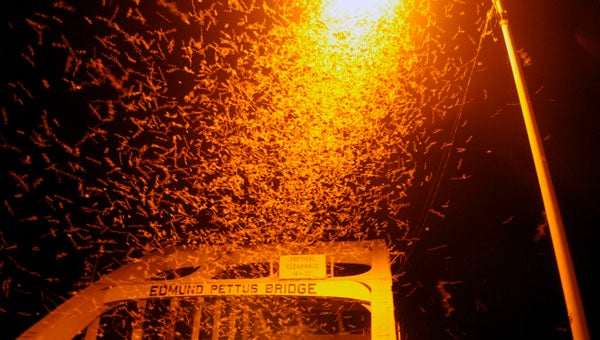The mayflies are coming!
Published 5:30 pm Saturday, August 10, 2013

Mayflies swarm around Water Avenue and the Edmund Pettus Bridge each year arrived Friday up from the waters of the Alabama River for two weeks of mating. — Ashley Johnson
Friday night was the first night for the 2013 mating season for a species of insects that swarm the city around the river area — leaving behind a sea of feathery wings and dust in piles all over Water Avenue.
For years mayflies, or willow flies, mate by swarming up from the Alabama River causing a flurry of insects — which some say is as close to snow as it comes in Selma.
On the Edmund Pettus Bridge, millions of the mayflies swarm to the streetlights. Because of their lifecycle lasting sometimes only hours, millions of the bugs lie dead on the street, inches thick making a sound similar to leaves crunching when cars whiz over them.
The Greek name for the insect found in Selma is Ephemeroptera, which translates to “short-lived” or “lasting a day.” This is because their lifecycle, which begins in the water, is short and they are only in the adult form as the moth-like creature for one day to reproduce before they quickly die.
In Hungary the hatch of millions of mayflies is a tourist attraction and in places like Africa, natives eat the insects for protein when they arrive.
Because the phenomenon has happened for hundreds of years, some believe it happened when the native American population occupied Old Cahawba Park, which is located on the river, likely an area mayflies populated.
Park employee Jack Bergstresser said it is known among fisherman that fish bite when the mayflies are swarming, and he speculates the natives at Old Cahawba could have realized this.
“I would imagine prehistoric inhabitants of Old Cahawba would have had that same knowledge and would have fished when the mayflies were out,” he said. “But that is just speculation.”
As residents of Selma encounter the mayflies, they should not be worried for their safety. The insects cannot open their mouths to bite or eat and have no stingers. Their swarms in incredible numbers do impair vision however, so drivers should proceed with caution.
According to a study done by Penn State Erie, the arrival of the bugs is a sign of good water quality. Researchers with Sea Grant Pennsylvania wrote that mayflies were abundant in the waters of Lake Erie until the 1950s when pollution turned their population away. The pollution created an upsurge in the algae in the lake, and oxygen levels were depleted.
These oxygen levels are so vital because the mayflies begin as nymphs, or creatures that live in the water living off of the sediment.
Throughout several years they shed their outer skeleton and morph into a newer underwater creature. Finally they become adults, swim to the surface of the Alabama River at dawn and emerge as adults that seek mates along hard surfaces of Water Avenue. They land on everything from streetlights, parked cars and roadways.
According to researchers with Biofresh Platform, a network working towards global freshwater biodiversity, the mayfly males swarm above the water and females enter the swarm to mate.
Once mated, the female falls into the river motionless and is usually eaten by fish. The male usually dies on land — meaning the piles of bugs on Water Avenue are mostly of the male population.
The fertilized eggs from the female fall into the water where the process begins again for a Selma “snow storm” in August 2014.





